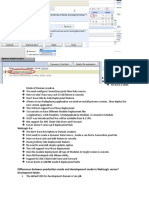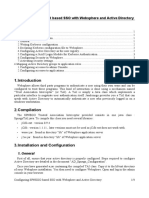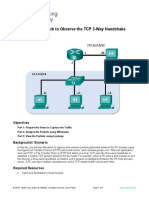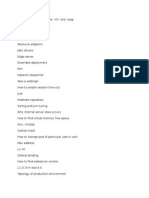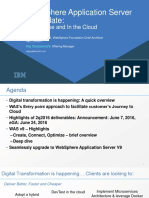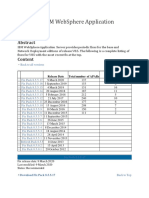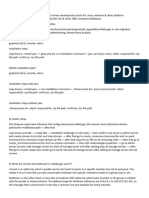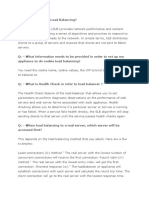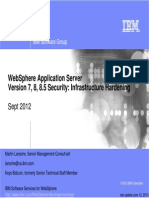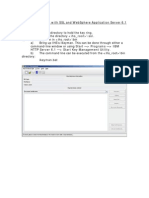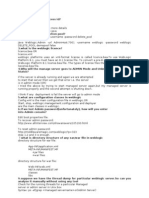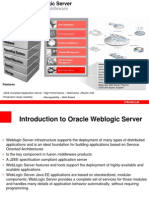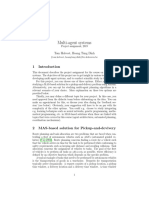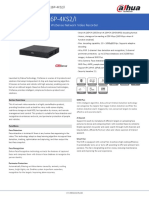Weblogic Interview Questions http://www.javabeat.net/articles/print.php?
article_id=199
Source : www.javabeat.net
Weblogic Interview Questions
Author : JavaBeat
Date : Thu Aug 5th, 2010
Topic : interview-questions
Weblogic Interview Questions - 1
1)How do I provide user credentials for starting a server?
When you create a domain, the Configuration Wizard prompts you to provide the username and
password for an initial administrative user. If you create the domain in development mode, the wizard
saves the username and encrypted password in a boot identity file. A WebLogic Server instance can
refer to a boot identity file during its startup process. If a server instance does not find such a file, it
prompts you to enter credentials.
If you create a domain in production mode, or if you want to change user credentials in an existing boot
identity file, you can create a new boot identity file.
2)Can I start a Managed Server if the Administration Server is unavailable?
By default, if a Managed Server is unable to connect to the specified Administration Server during
startup, it can retrieve its configuration by reading a configuration file and other files directly. You
cannot change the server's configuration until the Administration Server is available. A Managed Server
that starts in this way is running in Managed Server Independence mode.
3)What is the function of T3 in WebLogic Server?
T3 provides a framework for WebLogic Server messages that support for enhancements. These
enhancements include abbreviations and features, such as object replacement, that work in the context
of WebLogic Server clusters and HTTP and other product tunneling. T3 predates Java Object
Serialization and RMI, while closely tracking and leveraging these specifications. T3 is a superset of
Java Object. Serialization or RMI; anything you can do in Java Object Serialization and RMI can be done
over T3. T3 is mandated between WebLogic Servers and between programmatic clients and a WebLogic
Server cluster. HTTP and IIOP are optional protocols that can be used to communicate between other
processes and WebLogic Server. It depends on what you want to do. For example, when you want to
communicate between a browser and WebLogic Server-use HTTP, or an ORB and WebLogic Server-IIOP.
4)How do you set the classpath?
WebLogic Server installs the following script that you can use to set the classpath that a server
requires:
WL_HOME\server\bin\setWLSEnv.cmd (on Windows)
WL_HOME/server/bin/setWLSEnv.sh (on UNIX)
1 of 4 1/6/2011 2:41 AM
�Weblogic Interview Questions http://www.javabeat.net/articles/print.php?article_id=199
5)How do stubs work in a WebLogic Server cluster?
Clients that connect to a WebLogic Server cluster and look up a clustered object obtain a replica-aware
stub for the object. This stub contains the list of available server instances that host implementations of
the object. The stub also contains the load balancing logic for distributing the load among its host
servers.
What happens when a failure occurs and the stub cannot connect to a WebLogic Server instance?
When the failure occurs, the stub removes the failed server instance from its list. If there are no
servers left in its list, the stubb uses DNS again to find a running server and obtain a current list of
running instances. Also, the stub periodically refreshes its list of available server instances in the
cluster; this allows the stub to take advantage of new servers as they are added to the cluster.
6)How does a server know when another server is unavailable?
WebLogic Server uses two mechanisms to determine if a given server instance is unavailable.
Each WebLogic Server instance in a cluster uses multicast to broadcast regular "heartbeat" messages
that advertise its availability. By monitoring heartbeat messages, server instances in a cluster
determine when a server instance has failed. The other server instances will drop a server instance
from the cluster, if they do not receive three consecutive heartbeats from that server instance
WebLogic Server also monitors socket errors to determine the availability of a server instance. For
example, if server instance A has an open socket to server instance B, and the socket unexpectedly
closes, server A assumes that server B is offline.
7)How are notifications made when a server is added to a cluster?
The WebLogic Server cluster broadcasts the availability of a new server instance each time a new
instance joins the cluster. Cluster-aware stubs also periodically update their list of available server
instances.
8)How do clients handle DNS requests to failed servers?
If a server fails and DNS continues to send requests to the unavailable machine, this can waste
bandwidth. For a Java client application, this problem occurs only during startup. WebLogic Server
caches the DNS entries and removes the unavailable ones, to prevent the client from accessing a failed
server twice.
Failed servers can be more of a problem for browser-based clients, because they always use DNS. To
avoid unnecessary DNS requests with browser-based clients, use a third-party load-balancer such as
Resonate, BigIP, Alteon, and LocalDirector. These products mask multiple DNS addresses as a single
address. They also provide more sophisticated load-balancing options than round-robin, and they keep
track of failed servers to avoid routing unnecessary requests.
9)How many WebLogic Servers can I have on a multi-cpu machine?
There are many possible configurations and each has its own advantages and disadvantages. BEA
WebLogic Server has no built-in limit for the number of server instances that can reside in a cluster.
2 of 4 1/6/2011 2:41 AM
�Weblogic Interview Questions http://www.javabeat.net/articles/print.php?article_id=199
Large, multi-processor servers such as Sun Microsystems, Inc. Sun Enterprise 10000, therefore, can
host very large clusters or multiple clusters.
In most cases, WebLogic Server clusters scale best when deployed with one WebLogic Server instance
for every two CPUs. However, as with all capacity planning, you should test the actual deployment with
your target web applications to determine the optimal number and distribution of server instances.
10)How can I set deployment order for applications?
WebLogic Server allows you to select the load order for applications. WebLogic Server deploys
server-level resources (first JDBC and then JMS) before deploying applications. Applications are
deployed in this order: connectors, then EJBs, then Web Applications. If the application is an EAR, the
individual components are loaded in the order in which they are declared in the application.xml
deployment descriptor.
Weblogic Interview Questions - 2
1)Can I refresh static components of a deployed application without having to
redeploy the entire application?
Yes. You can use weblogic.Deployer to specify a component and target a server, using the following
syntax:
java weblogic.Deployer -adminurl http://admin:7001 -name appname -targets server1,server2 -deploy
jsps/*.jsp
2)When should I use the -nostage option?
Set the staging mode to -nostage (using weblogic.Deployer or the Administration Console) if you don't
want to copy deployment files but want to deploy an application from its present location. All target
servers must be able to access the same set of deployment files.
3)When should I use the external_stage option?
Set -external_stage using weblogic.Deployer if you want to stage the application yourself, and prefer to
copy it to its target by your own means.
4)Can I set the deployment order for application modules? For standalone
modules?
The Load Order attribute controls the deployment order of standalone modules and applications relative
to other modules and applications of the same type. For example, standalone EJBs with smaller Load
Order values are deployed before those with higher values.
Modules that are deployed as part of an Enterprise Application (EAR file or directory) are deployed in
the order in which they are specified in the application.xml deployment descriptor.
3 of 4 1/6/2011 2:41 AM
�Weblogic Interview Questions http://www.javabeat.net/articles/print.php?article_id=199
What is the difference between the WL_HOME/config/examples/applications folder and the
WL_HOME/config/examples/stage folder?
The applications folder is intended for applications that are not yet ready for a production environment.
WebLogic Server dynamically deploys the contents of the applications folder. The stage folder (or a
folder that you create for the same purpose) is for storing copies of deployment files that are ready for
deployment in a production environment (deployments that use the stage or external_stage deployment
modes).
5)How do I turn the auto-deployment feature off?
The auto-deployment feature checks the applications folder every three seconds to determine whether
there are any new applications or any changes to existing applications and then dynamically deploys
these changes.
The auto-deployment feature is enabled for servers that run in development mode. To disable
auto-deployment feature, use one of the following methods to place servers in production mode:
* In the Administration Console, click the name of the domain in the left pane, then select the
Production Mode checkbox in the right pane.
* At the command line, include the following argument when starting the domain's Administration
Server:
-Dweblogic.ProductionModeEnabled=true
Production mode is set for all WebLogic Server instances in a given domain.
6)Must EJBs be homogeneously deployed across a cluster? Why?
Yes. In WebLogic Server 6.0 and later, EJBs must be homogeneously deployed across a cluster for the
following reasons:
* To keep clustering EJBs simple
* To improve performance by avoiding cross-server calls. If EJBs are not deployed on all servers,
cross-server calls are more likely.
* To ensure that every EJB is available locall.y
* To ensure that all classes are loaded in an undeployable way. Every server must have access to
each EJB's classes so that it can be bound into the local JNDI tree. If only a subset of the servers
deploys the bean, the other servers will have to load the bean's classes in their respective system
classpaths which makes it impossible to undeploy the beans.
Source : www.javabeat.net
4 of 4 1/6/2011 2:41 AM







